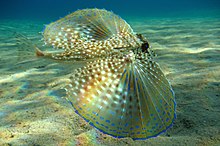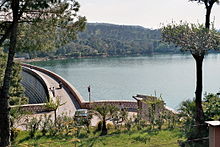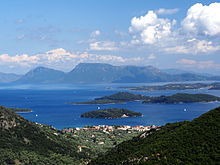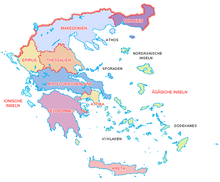Greece
![]()
This article is about the state. For other meanings, see Greece (disambiguation).
Template:Infobox State/Maintenance/TRANSCRIPTION
Template:Infobox State/Maintenance/NAME-German
Greece (Greek Ελλάδα [ɛˈlaða], Elláda, formally Ελλάς, Ellás 'Hellas'; official full form Ελληνική Δημοκρατία, Ellinikí Dimokratía 'Hellenic Republic') is a state in southeastern Europe and a Mediterranean littoral state. The Greek territory borders Albania, northern Macedonia, Bulgaria and Turkey. Greece is a parliamentary republic with presidential elements; executive power is vested in the government, and to a lesser extent in the president. The capital of the country is Athens. Other major cities are Thessaloniki, Patras, Iraklio and Piraeus.
Ancient Greece is known as an early European advanced civilization that produced important achievements such as Attic democracy and philosophy, early natural sciences, and classical Greek architecture. After the end of antiquity and its absorption into various great empires such as Byzantium and the Ottoman Empire, it was not until the 19th century, in the wake of the Greek Revolution and subsequent independence from the Ottomans, that a Greek state was once again formed. Today's parliamentary presidential democracy goes back to the referendum in December 1974 for the abolition of the monarchy and the introduction of the republic.
Greece is a member of the United Nations, the OECD, NATO (since 1952), the OSCE and the Council of Europe. In 1981, Greece was admitted to the European Community. On 1 January 2001, Greece joined the Eurozone.
Measured by the Human Development Index (HDI), Greece is one of the very highly developed countries. The tourism and trade sectors are particularly important economically. The manufacturing sector is (as of 2015) of minor importance compared to other highly developed countries. The food industry and metal processing have a significant share in the industrial sector. After a long recession or stagnation of the economy since 2008, the economy has been recovering since 2017; Greece's unemployment rate is the highest in the European Union.
Term and designation
→ Main article: Designations for the Greeks
Modern Greeks call themselves Hellenes (Greek Έλληνες, Ellines), but they have had numerous different designations throughout history. Homer (8th century BC) did not use the term "Hellene" in his epics. Even in classical antiquity, the Hellenes placed little emphasis on presenting themselves as a unified nation. Instead, their own homeland, be it a polis or a kingdom, was the main focus, with only a few exceptions. For example, the soldiers who fell at Thermopylae were called Hellenes. Participants in the Olympic Games were also grouped together as Hellenes. Perhaps for this reason, this very name was later synonymous with paganism in the first centuries of Christianity. From late antiquity until the end of the Middle Ages (1453), the Greeks called themselves Rhōmaioi (ancient Greek Ῥωμαῖοι 'Romans'). A wide variety of historical developments influenced their self-designation. These varying names were either entirely new, or had been used before and had fallen into oblivion. They were significant in each of their times, and may now be regarded as interchangeable, implying that many-namedness applies to the people of the Greeks.
In most European languages and those languages that have adopted their names, the name for Greece begins with the letters gr. The origin of all these names lies in the Latin term Graecus, which in turn originated in the Greek Graikos (Γραικός), the name of a Boeotian tribe that settled in Italy in the 8th century BC, and by whose name the Hellenes became known in the West. Homer mentions in the Iliad the Boeotian city of Graia (Γραῖα); according to Pausanias this was the ancient name of Tanagra. Kyme, a city south of Rome and northwest of Naples, was founded by Greeks from the cities of Chalcis and Graia. The contact of the latter with the Romans may have given rise to the term Graeci as a collective name for all Hellenes.
On the other hand, the Persian and Turkish names of the Greeks Yunan, as well as those of most other Near Eastern languages, originally go back to Old Persian Yauna, which in turn is borrowed from Greek Íōnes (Ἴωνες). The eponym here was the Greek tribe of the Ionians, whose cities were conquered by the Persians in the sixth century B.C. and whose name, similar to the name of the Graeci in the West, came to refer to the entirety of the Hellenes.
Geography
Greece is located on the eastern Mediterranean Sea in southern Europe and is geographically composed of the Greek mainland at the southern end of the Balkans, the Peloponnese peninsula, which, however, was separated from the mainland by the construction of the Corinth Canal (inaugurated in 1893), and numerous islands located mainly in the Aegean Sea, the Ionian Sea, but also in the Libyan Sea. The political border to the north is formed by the states of Albania (282 km), Northern Macedonia (228 km) and Bulgaria (494 km), and to the east by Turkey (206 km). A natural border is formed by the Ionian Sea in the west of the country with the Italian peninsula and Sicily, and the Libyan Sea in the extreme south with the African continent. The island of Gavdos in the Libyan Sea is the southernmost point of the country and is also geographically considered the southernmost point of Europe.
The country has a total area of 131,957 km²: 106,915 km² are on the mainland, 25,042 km² (just under 19%) are distributed over 3,054 islands, 87 of which are inhabited. Due to the abundance of islands, Greece has a remarkable coastline of 13,676 km, of which about 4,000 km are on the Greek mainland. The sometimes quite large distances within the country represent another geographical feature in relation to its relatively small total area. For example, as the crow flies, the distance between the island of Othoni near Corfu and the island of Kastelorizo in the extreme southeast of Greece is 983 km. The smallest geographical extent of the country - less than 550 km as the crow flies - is in the east-west direction.
Greece, despite its strongly maritime character, has a mountainous proportion of 77.9% and is therefore classified as a mountainous country. Central mountains and mountain ranges of the country are the Pindos mountains, the Olymp-Ossa-Pilion mountain range as well as the Rhodope mountains on the Greek mainland, the Taygetos mountains on the peninsula of Peloponnese and furthermore the Ida and Psiloritis mountains on the island of Crete. The highest elevation of the country is the Mytikas (2917 m) in the mountain range of the Olymp. Larger economically exploitable plains are sparse and are mainly located in the regions of Thessaly, Macedonia and Thrace.
See also: List of Greek islands and List of mountains in Greece
Waters
Larger rivers that carry water all year round are found mainly in the north of mainland Greece, where they are used for irrigation of the fertile valleys and for a small amount of energy production. Among them are the Pinios, Axios, Strymonas, Nestos and Evros. In southern Greece most of the rivers carry water only seasonally, but can turn into raging torrents in the rainy season. The Kifisos flows through Attica. The Evros, now the border river, was once used for inland navigation. The north of Greece lies in the Blue Heart of Europe.
The Greek lake landscape is little known and consists of about half natural lakes and more recent reservoirs. Lake Trichonida in Aetolia-Accarnania has a surface area of 96 km² and a depth of 57 m, making it one of the three largest natural lakes in Greece. The surrounding eucalyptus and olive groves are habitats for over 140 species of birds, and the lake itself for some rare species of fish. Also in Aetolia-Accarnania is the 92 km² Cremasta reservoir, fed mainly by the Acheloos.
Climate
Greece has a predominantly Mediterranean climate with mild, humid winters and hot, dry summers. On the coast it is very mild in winter and it rains frequently; snow falls only rarely. Summers are relatively hot with only occasional summer thunderstorms. The continental European heat record of 48° was measured in Greece in 1977.
Inland, it is much cooler, especially in winter, with frequent night frosts and sometimes heavy snowfall. Spring is short, but spoils "with fireworks of lavender and anemones, corn poppies and chamomile". In summer, similar to the coast, it is hot and dry. The annual rainfall varies between 400 and 1000 mm. Since Greece is very mountainous, winter sports are quite possible, there are 19 winter sports areas of different sizes. A small part in the northwest of the mainland is in the temperate climate zone.
flora and fauna
Flora and fauna are culturally closely associated with ancient myths, but less often with the main deities. Chloris was the goddess of flowers who made plants sprout for Hera, nymphs were responsible for the life of plants. The shepherd god Pan was also considered the god of the forest and nature. Often in Greek mythology, gods take the form of natural phenomena or of animals. The prefix bio- goes back to the Greek word bios for life.
Forests were already cleared in ancient times. The wood was used for cooking, for heating, as timber or for shipbuilding; the cleared areas were used as farmland or pasture. In 2005, there were 3,752,000 hectares of forest and 2,780,000 hectares of other forested land. About 80% of the forest is state-owned. Where there is no agriculture today, hard-leaved plants grow (Erica, strawberry tree, real laurel, carob tree). Due to the mountainous structure, many slopes have been left bare by soil erosion. Nevertheless, Greece is one of the most species-rich countries in Europe and in terms of the diversity of medicinally useful plants, it is surpassed only by Madagascar. This is due to the numerous islands and remote valleys. In total, Natura 2000 lists '241 habitats of Community Importance' (SCI) and 202 Special Protection Areas (SPA). Of the 5500-6000 plant species and subspecies in Greece, 20% are endemic, and the high number of species includes a higher than average proportion of medicinal plants. They once formed the basis for a distinct folk medicine, as well as for the Asclepiads. Evergreen plants (broad-leaved, sclerophyllus (hard-leaved)) make up the majority of the vegetation.
Trees include the culturally and economically important olive tree, pines, Aleppo pines, cypresses, fruit trees and palms in coastal regions. From an altitude of 1000 m chestnuts, elms and oaks occur, up to 2000 m black pines and Apollo firs, above the tree line also alpine mats. Among the endemic trees is the Kefalonian fir.
It is also due to large climatic differences between the mountains and the coasts as well as the mild climate that the country is so rich in species. Much of the very small-scale habitats are difficult to access and therefore protected from human influences such as settlement or tourism. There are more than 900 animal species, including geckos, lizards (e.g. the green lizard), the Greek land tortoise, in the mountains also deer, wild boars and foxes, occasionally also wolves and bears. The fauna of the islands differs considerably from that of the mainland. Regionally, there are, for example, the loggerhead turtle on Zakynthos and, as one of the endemic species, the Cretan wild goat on Crete. The butterfly valley on Rhodes is home to the rare butterfly species Russian bear. Lagoon and wetland areas lead to an abundance of bird species. There are 36 of the 38 European species; 23 of them breed in the area.
The local flora and fauna are protected in ten national parks and two marine national parks. Greece has shares in the European Green Belt.
The Greek term for hunter (Kynigós) is derived from the ancient Greek word Kyôn (Gen. Kynós) for dog, already in ancient times there was a large variety of dogs in Greece. From Xenophon the writing Kynegetikós (book about the hunt) is handed down, which describes abilities and use of the dog in particular for the hunt. There are only a few Greek dog breeds, for example the Hellinikos Ichnilatis and the Kritikos Lagonikos.

Olive grove near Alexandroupolis

A Mediterranean wheatear at a monastery on Lesbos

Flying fowl (Dactylopterus volitans) in the Mediterranean Sea off eastern Crete, about 3-5 m depth.

Mount Olympus

Marathon Lake with the dam built in 1926

Mediterranean landscape on Lefkada

A lake in Epirus, in the mountains above the tree line

Regional division of Greece
Questions and Answers
Q: What is the capital of Greece?
A: The capital city of Greece is Athens.
Q: What are the bordering countries to Greece?
A: Greece borders Albania, North Macedonia and Bulgaria to the north, and Turkey to the east.
Q: What seas border mainland Greece?
A: The Aegean Sea is to the East and South of mainland Greece, while the Ionian Sea is to the West. Both are part of the Eastern Mediterranean Sea.
Q: What percentage of Greece is mountainous?
A: 80% of the country is mountainous.
Q: Who was Alexander the Great?
A: Alexander the Great was a king from ancient Macedonia who established an empire that stretched across much of Europe and Asia in antiquity.
Q: How many languages do Greeks speak?
A: Greek is spoken by 99% of Greeks as their native language, while 90% also understand English, French and German which are taught in schools.
Q: When did Greece become a member of NATO?
A:Greece joined NATO in 1952.
Search within the encyclopedia